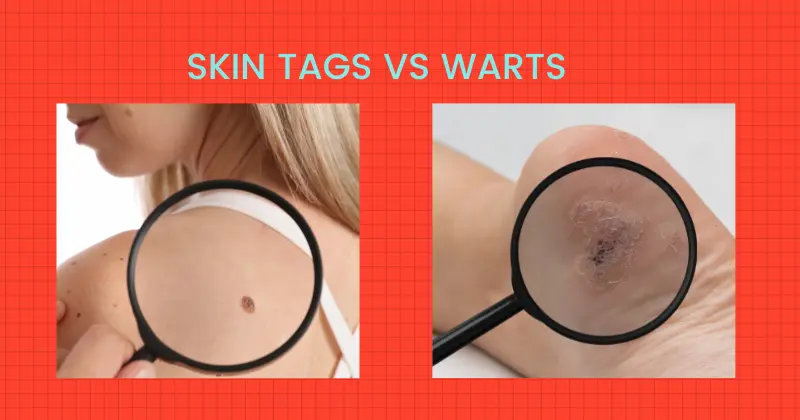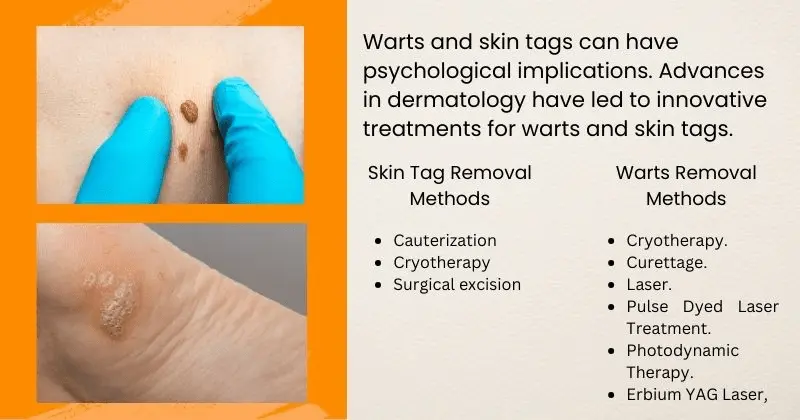Warts vs Skin Tags: Understanding the Symptoms, Causes, and How to Treat Them.

Are you tired of dealing with annoying growths on your skin, like skin tags and warts? You’re not alone. Skin tags and warts are common dermatological issues that affect people of all ages. But understanding their symptoms, causes, and treatment options can help you effectively battle these blemishes.
In this article, we’ll understand skin tags vs. warts, their symptoms, causes, and treatment options. Whether you want to learn more about identifying these growths or discover effective remedies to get rid of them, we’ve got you covered.
What are Skin Tags and Warts?
Skin tags are small, soft growths that hang off the skin and are usually harmless. They commonly appear in areas with friction, such as the neck, armpits, and groin. Skin tags are composed of collagen fibers and blood vessels covered by a layer of skin. They can vary in size and shape, with some being as small as a pinhead and others as large as a grape.
Warts, on the other hand, are caused by the human papillomavirus (HPV) and can manifest as small, rough bumps on the skin. There are several types of warts, including common warts, flat warts, plantar warts, and genital warts. Warts are highly contagious and can be spread through direct contact with the virus, such as touching or scratching the affected area.
Symptoms and Causes of Skin Tags
Skin tags are usually painless and do not cause any symptoms unless they become irritated or inflamed. They are more common in individuals who are overweight or have diabetes. Hormonal changes during pregnancy or menopause can also contribute to the development of skin tags.
The exact cause of skin tags is unknown, but friction and rubbing of the skin are believed to play a role. Areas of the body where skin rubs against skin or clothing, such as the neck, underarms, and groin, are more prone to developing skin tags. Additionally, genetics may also play a role in their formation.
Symptoms and Causes of Warts
Warts can vary in appearance depending on the type and location. Common warts typically appear as rough, raised bumps with a cauliflower-like texture. Flat warts are small and smooth, often appearing in clusters on the face, neck, or hands. Plantar warts develop on the soles of the feet and can cause discomfort or pain when walking. Genital warts appear on the genital area and can be sexually transmitted.
The primary cause of warts is the human papillomavirus (HPV). There are over 100 different strains of HPV, and each strain can cause different types of warts. Warts are highly contagious and can be spread through direct contact with an infected person or by touching surfaces contaminated with the virus. Individuals with weakened immune systems are more susceptible to developing warts.
Are Skin Tags Same as Warts – Skin Tag vs Wart:
How to Remove Skin Tags At Home:

If you have a skin tag that is causing irritation or affecting your self-esteem, there are several home remedies you can try to remove.
One popular method is to tie a small piece of dental floss or thread tightly around the base of the skin tag. This cuts off the blood supply to the tag, causing it to eventually fall off. It is important to ensure that the area is clean and disinfected before attempting this method to avoid infection.
Another home remedy is to apply apple cider vinegar to the skin tag using a cotton ball. The acidic properties of apple cider vinegar help break down the tissue, gradually causing the tag to shrink and fall off. However, this method may take several weeks or even months to show results.
If you prefer a more natural approach, you can try applying tea tree oil or castor oil to the skin tag. These oils have properties that can help dry out the tag and promote its removal. Simply dab a small amount of oil onto the tag and cover it with a bandage. Repeat this process daily until the tag disappears.
Medical Treatments for Skin Tags Removal:
If home remedies do not provide the desired results or if you have multiple skin tags that require professional attention, there are medical treatments available.
Cauterization: One common method used by healthcare professionals is cauterization. This involves using a heated instrument to burn off the skin tag. Local anesthesia is often administered to minimize discomfort during the procedure. Cauterization is a quick and effective way to remove skin tags, and the healing process is usually straightforward.
Cryotherapy is another medical treatment option for skin tags. It involves freezing the tag using liquid nitrogen, which causes the tissue to die and eventually fall off. Multiple cryotherapy sessions may be required for larger or stubborn tags. This procedure is generally well-tolerated, but some individuals may experience temporary discomfort or blistering in the treated area.
Surgical excision is reserved for larger or more complex skin tags that cannot be easily removed by other methods. This procedure involves cutting the tag off using a scalpel or surgical scissors. Local anesthesia is typically used to numb the area before the excision. Surgical excision may result in a small scar, but proper wound care can help minimize scarring.
Skin Tag Removal Cost:
Skin tag removal fees vary based on the number of tags removed and location. In Columbus, Ohio, removal of up to 15 skin tags costs $156, with an additional $53 for each batch of 10. In New Orleans, the same procedure costs $603. According to Healthcare Bluebook, the “fair price” in Columbus for removing an unspecified number of skin tags is $208.
Best Skin Tag Removal Products & Stores:
Home Remedies for Warts:
Warts can be stubborn and difficult to eliminate, but there are several home remedies that may help speed up the healing process.
One popular method is to apply salicylic acid, tretinoin, and glycolic acid, which help peel off layers of the wart. Immune-stimulating creams like imiquimod (Aldara) and diphencyprone (DCP) can promote the shrinking and disappearance of warts. Additionally, topical 5-fluorouracil inhibits the growth of extra cells in warts.
14 out of 100 people get rid of their warts faster by using salicylic acid.
Duct tape occlusion therapy is another home remedy that has shown some success in treating warts. Simply cover the wart with a piece of duct tape and leave it in place for about six days. After removing the tape, soak the wart in warm water and gently scrub it with a pumice stone or emery board. Repeat this process until the wart disappears.
Some individuals have found success with natural remedies such as applying crushed garlic, banana peel, or aloe vera gel to the wart. These remedies are believed to have antiviral properties that can help fight the HPV virus. However, scientific evidence supporting their effectiveness is limited, and results may vary.
Other Treatments for Warts:
We will not recommend using these home remedies as self-treatment is always dangerous. It is better to seek medical treatment. These medical treatments are not very effective.
- Cryotherapy: In this method, extremely cold nitrogen liquid is applied to the wart using any technique, like cotton swabs or spray. The method is repeated several times with at least a break of one weak. However, this method is not recommended for diabetic patients. It is not effective in removing warts on feet.
- Curettage: it involves cutting or scraping off warts with special tools. But at first, salicylic acid plaster or solution is applied to the warts.
- Laser: in this method, the laser beam is being used to destroy the wart. It may cause scarring.
- Pulse Dyed Laser Treatment: In this method, a laser beam destroys the narrow blood vessels and cuts the supply of blood to the wart.
- Photodynamic Therapy: In this method, after applying gel to the wart, leave it for about three hours. This gel has a special chemical substance that is activated by light and destroys the wart tissue.
- Erbium YAG Laser: This method aims to destroy the wart cell by heating it with fluid.
Best Wart Removal Products & Stores:
- Dr. Scholl’s Clear Away Wart Remover.
-
WartStick Maximum Strength Salicylic Acid Solid-Stick Common and Plantar Wart.
The dermatologist at the skincare tips does not recommend using these home remedies at home to avoid any complications. This treatment, without your dermatologist’s recommendation, may worsen the condition.
Wart Removal Cost:
The cost of wart removal depends on a number of factors, such as the clinic’s location, wart removal session, etc., but normally it varies from $200-$500.
Risk Associated With Tag And Wart Removers:
According to research, unapproved mole and skin tag removers can lead to severe skin injuries, as indicated by consistent reports across various product reviews. Prior to using any remedies or products for wart or tag removal, consulting a dermatologist is strongly advised.
Prevention Tips for Skin Tags and Warts:
There are steps you can take to reduce your risk of developing these growths.
To prevent skin tags, it is important to maintain good hygiene and keep the skin clean and dry. Avoid wearing tight-fitting clothing that may cause friction or irritation. If you are prone to skin tags, consider using talcum powder or other moisture-absorbing products to keep the affected areas dry.
To prevent warts, practice good hand hygiene by washing your hands regularly with soap and water. Avoid touching warts on yourself or others, as this can spread the virus. If you have a wart, cover it with a bandage to reduce the risk of transmission. Additionally, avoid sharing personal items such as towels, razors, or nail clippers to prevent the spread of the virus.
Related Post:
-
Laser Mole Removal | Mole Causes | Laser Mole Treatment
-
Types of Laser Treatment For Skin | Skin Treatment With Lasers | Skin Aesthetic
Conclusion:
Skin tags and warts may be common skin issues, but understanding their symptoms, causes, and treatment options can help you effectively deal with them. Whether you choose to try home remedies or seek medical treatment, it is important to consult with a healthcare professional for proper diagnosis and personalized advice.
Everyone’s skin is unique, and what works for one person may not work for another. Be patient and persistent in your battle against skin tags and warts, and don’t hesitate to seek professional help if needed. With the right knowledge and treatment, you can reclaim clear, healthy skin and regain confidence.
Resources:
https://pubmed.ncbi.nlm.nih.gov/31613504/
https://www.ncbi.nlm.nih.gov/books/NBK547724/#:~:text=Some%20patients%20may%20require%20an,%2C%20snip%20excision%2C%20or%20cryosurgery.
https://www.ncbi.nlm.nih.gov/pmc/articles/PMC9891211/
https://www.ncbi.nlm.nih.gov/books/NBK279585/
https://www.ncbi.nlm.nih.gov/pmc/articles/PMC1764803
https://www.ncbi.nlm.nih.gov/books/NBK279585/#:~:text=Curettage%3A%20Curettage%20involves%20cutting%20or,This%20treatment%20can%20cause%20scarring.

